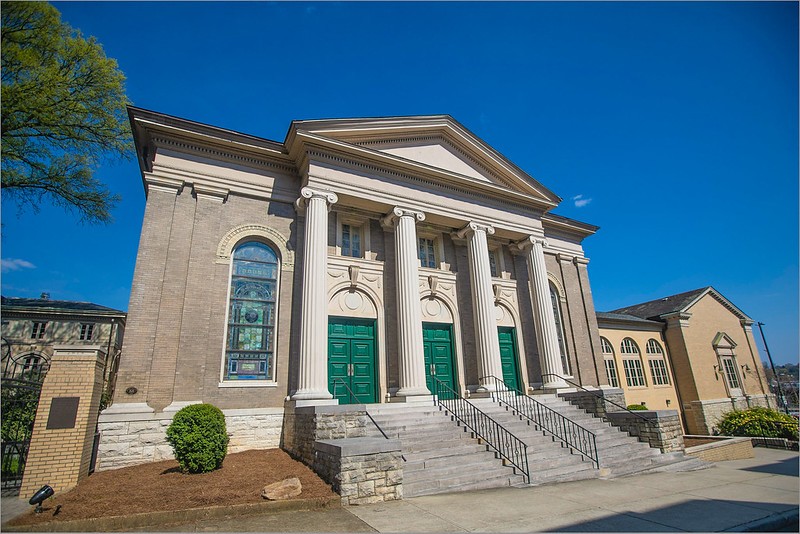2022 marks the 230th anniversary of First Presbyterian Church, the oldest worship community in Knoxville and Knox County. That’s impressive, yet 230 years isn’t a milestone commonly seen as a time for a big party.
But there’s a reason First Pres, as it’s fondly known, was first. The church has a history of being on the cutting edge.

Passersby are alerted to the church’s history by a marker. (FPC photo)
“One of the things that I’ve learned about First Presbyterian Church is they just love celebrating,” says the Rev. Mark Curtis, who became the church’s senior pastor in November 2021. “They love celebrating what God has done here at the church, has done in their lives, and want any opportunity to invite new folks to come and experience the great things that are happening at First Presbyterian.”
Sunday, Oct. 30, will be a special day at the church. At 9:45 a.m., Knoxville historian Jack Neely, a member whose family has belonged to the church for generations, will lead a conversation in the chapel about First Presbyterian’s history. The 11 a.m. service will begin with a bagpiper and drummer and a “Kirking of the Tartans” – a ceremony blessing Scottish clan members. The Presbyterian Church is rooted in the Church of Scotland, and “kirk” is the Scottish word for “church.”

The pastor and his family, clockwise from right: wife Diana, sons Asher and Daniel, and Mark Curtis. (FPC photo)
“People are very excited,” says Curtis, a Sacramento, California, native who moved to East Tennessee in 2006 after studying at Princeton Theological Seminary. (He served at New Providence in Maryville and Lake Forest in South Knoxville before being called to First Presbyterian.) “People have been hoping to do a Kirking of the Tartans service again. It’s been several years since the church has had that type of service. They’re also very excited to celebrate 230 years.”
Organist/choir director Mark Pace, a North Carolina native who has been at First Pres for six and a half years, previously served for 13 years at St. Paul’s Episcopal Church in Concord, New Hampshire. He was involved with several Kirking services while in New England.
“They’re really beautiful services with all the bagpipes, and the clans come and all the clans bring banners of their different families.”
Anyone with Scottish heritage is welcome to participate, not just church members. Pace simply asks that people arrive at 10 a.m. so that he can organize and instruct them for the ceremony.
“We could have three or four or we could have 30,” he says, noting that he contacted the St. Andrew’s Society to help spread the word. “We have no idea how many people might come.”
He recruited the piper and drummer from Knoxville Pipe and Drums.
Pace says the clans proceed into the sanctuary at the beginning of the service and each family states its clan name. There’s then a prayer over the clans and some other pronouncements and then the clans recede to their pews for the remainder of the service.
Pace jokes that the clan members have to stay for the sermon.
“And the anthem! You don’t get to leave until at the very end when the bagpiper and the drummer play ‘Scotland the Brave’ for the postlude. You have to sit and behave yourself for an hour.”
After the service, at 12:15 p.m., the church is holding a celebratory catered lunch in the Fellowship Hall; cost is $10 adult, $5 child, $30 maximum per family. To see if space is still available, visit rsvpfirstpres.org.
First Presbyterian’s history is deeply tied to the history of Knoxville.

A church work crew poses on the Clinch Avenue side after a cleanup. (FPC photo)
In 1790, when Knoxville founder James White decided it was time to start a town on the land he’d purchased in 1783 between First Creek and Second Creek, he asked son-in-law Charles McClung to survey it. McClung laid out 64 half-acre lots, and White told him to reserve his own garden – alternating seasonally between corn and turnips – for a church and a graveyard.
First Presbyterian Church was formed in 1792 as Knoxville’s first church by Rev. Samuel Carrick. Services were held under groves of trees and other nearby locations during Carrick’s time, but after his death in 1809, a supply pastor named Samuel Ramsey preached a sermon that inspired church members to form a building committee.
Construction began in 1812 and was completed in 1814 on what was called the Brick Meeting House. The current chapel is now on that site.
Another building replaced the meeting house in 1853, and during the Civil War it was occupied first by Confederate troops and later by Union troops. It wasn’t until 1866 that the badly damaged church was returned to its congregation, and the members set about restoring it.

First Presbyterian in 1938 from the corner of Church Avenue and State Street (Thompson Photograph Collection, McClung Historical Collection)
The sanctuary building dates to 1903, while the chapel was built in 1962, and a major addition including the Family Life Center was completed in 1988. Curtis’ predecessor, William Pender, oversaw a major renovation that was finished in time for the 225th anniversary.
“I am so fortunate,” says Curtis, who at 43 is the youngest of the 15 or 16 pastors the church has had. “I feel like I’m reaping the benefits of all the hard work that the congregation has done – not just with the building itself, but also with mission work.
“I feel honored to be a part of the great history of the church, but also know that the congregation is excited for the next 230 years that God has planned. Everything that we’re celebrating, everything that we’re doing is because of the women and men, the saints, who came before us and made it possible. We know that God has plans to use this generation to prepare for the next generation.”
Betsy Pickle is a veteran freelance writer and editor.

